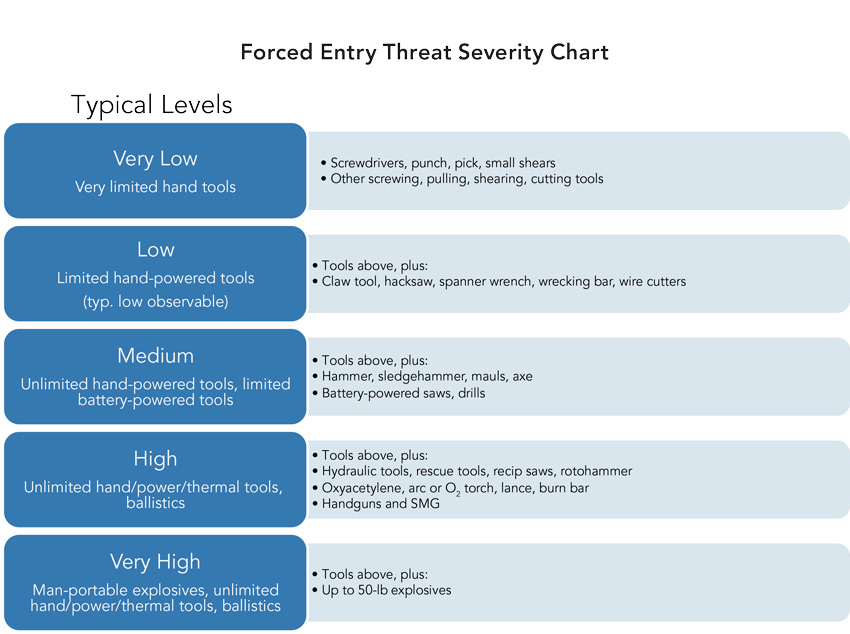Design to Protect
Forced Entry
The most dramatic instances of forced entry have often occurred overseas, when large groups of people have attacked military, diplomatic, or politically symbolic facilities. But these buildings are also the ones more likely to be fortified against attack, while the vast majority of buildings, particularly in this country, have civilian missions. Their structures and glazing are not typically designed to resist this kind of threat, and so are particularly vulnerable to forcible entry.
The technical definition of the forced-entry threat is attack by personnel using a range of tools and methods to penetrate the protective covering of a facility. The range of motives can be as wide and as mixed as the tools used: to make a statement, to obtain sensitive or valuable materials, to create damage, or to cause injury to personnel. The level of forced-entry protection that products can provide is, as with other threats, a complex calculation, and many standards and specifications, both in the United States and worldwide, have been developed to quantify what is possible and realistic to achieve.
The forced-entry threat severity takes into account the size of the attacking group (e.g., two people, six people, etc.) and the type of tools used. For example, the Department of Defense’s “low” level of protection simulates an unstructured attack by a two- or six-man team using hand tools.
The level of protection is typically measured in terms of the delay time the product provides before an opening of defined size and/or shape is created. This delay can provide time for the destruction of documents, time for people to move to more secure locations, or time for response by local authorities. For example, in the Department of State SD-STD-01.01 Rev G (Amended) and ASTM F3038 test methods, the failure criteria is at the point when a defined test shape passes through a hole in the material being tested.
The Forced Entry Threat Severity Chart shows typical levels of protection in relationship to tools used, ranging from very low levels of protection, where a tested material can protect against light hand tools such as screwdrivers and punch tools, to very high levels of protection, where a material can withstand attack from all the tools listed previously, plus personnel-carried explosives. This particular description is based on DOD terminology; the definition of severity levels from forced entry varies from agency to agency, as does the definition of levels of protection.

Image courtesy of Ross Technology
The Forced Entry Threat Resistance Diagram shows the levels of protection correlated to the delay time provided until a specific-size opening is created, as required by five different major standards.

Image courtesy of Ross Technology
As the level of protection against forced entry increases, the building requirements increase significantly. For example, to provide a low level of protection (e.g., 1 minute against hand tools), commercially available products such as 11/16-inch glass-clad poly with 3/8-inch poly layer may be sufficient. To provide a very high level of protection (delay time) against this relatively low threat may require a laminate of 2 inches or more. For more severe threats and higher levels of protection, typical commercial window products are not realistic, and protection may have to include strongly reinforced doors with concrete fill, metal mesh, and other special features, together with heavily reinforced walls and other building structures.
As a point of reference regarding the severity of an attack using only hand tools, a single test for a product to meet a 60-minute level of forced-entry protection (ASTM F3038/DOS 60) can involve inflicting greater than 2,400 sledgehammer blows, along with attacks with combinations of pry bars, wood wedges, crowbars, and axes.
This video does not contain audio.
Video courtesy of Ross Technology
The systems shown in this short video are being tested using a variety of tools and techniques.
Glazing designed to resist forced entry generally includes layers of glass and thermoplastic materials (polycarbonate, acrylic). Products with higher amounts of plastic material are usually more resistant to blunt tool attacks, but glass provides resistance to sawing and cutting attacks. In addition, glass has features that are important in most buildings for aesthetics and also for transparency, light, vision, and scratch resistance. Frames can be manufactured from steel, armor plate, or thick aluminum; each has its advantages and disadvantages. Multiple anchorage locations can also increase the forced-entry resistance of the system.
There are a number of commercially available products in the United States that are rated as providing varying levels of protection against the forced-entry threat. These include systems rated to Department of State or ASTM F3038 standards, and individual components rated to H.P. White (independent testing organization) or ASTM F1233 standards. There are also a number of products in the United Kingdom and Europe that have been tested and classified to LPS1175 and EN 1627/1630 standards.
In addition, manufacturers—particularly those experienced in providing protection at Department of State/ASTM F3038 levels—have the capability to design and test proprietary laminates to resist forced-entry threats at various levels and to integrate them into a building’s other design priorities. This capability is also important in structures where designing for combined threats is an objective, because although a number of U.S. systems are rated for both forced entry and ballistic resistance, the addition of blast resistance is complex and usually requires specialized engineering that can only be provided by manufacturers with extensive expertise and experience.
Combined Threat Resistance
Any of the factors discussed so far can be selected as the main driver for a specific design: for example, many glazing systems are designed with resistance to high-power ballistics as a priority. Products and systems are available that combine features at a range of severity and protection levels to provide a range of forced-entry delay times and ballistic resistance. The systems employ combinations of laminates, window and door structures, and possibly louvers, hatches, and wall panels of various designs. However, adding blast resistance requires additional analysis and often involves proprietary laminates designed and manufactured specifically for the application.
The Combined Threat Resistance Chart indicates a general approach to selecting a few of the design features and requirements for providing combined threat resistance. The objective is to define levels of protection precisely and work toward a realistic, achievable range of combined resistance to the threats we have been discussing, at a level that would provide effective protection for buildings against attacks of the type and severity most commonly anticipated for buildings with heightened safety concerns in the United States. A low-to-mid level combined resistance is, in general, the highest level for which commercial architectural products are typically available. That range responds to the threats from weapons of choice such as vehicle bombs, widely available high-powered rifles with standard ammunition (e.g., AR-15s), and attacks by limited numbers of attackers.

Image courtesy of Ross Technology
These are general guidelines for assessing the situation and product requirements. However, in every case, it is of critical importance to analyze threat levels in terms of each structure’s unique mission, location, assets, resources, and design priorities. The threats are evolving and multifaceted, and the response must be as well.
Summary: Key Lessons
Fenestration elements are a critical part of threat resistance in buildings and are most effective when designed as parts of an integrated system. Many product design parameters can be precisely determined according to federal, commercial and proprietary standards, testing, and experience. At the same time, there is still the opportunity—and the requirement—to customize designs for specific applications in ways that will provide protection and enhance the overall function and architecture of the building. Experienced manufacturers can be important members of the team and help to:
- Perform detailed risk assessments
- Understand the nature of physical threats to buildings from explosive blast, ballistics, and forced entry
- Develop performance requirements necessary for products to meet defined levels of threat severity and protection
- Select products and design systems suitable for the specific project
- Integrate products into the building envelope
End Note
1Patterns of Terrorism in the United States, 1970–2014. National Consortium for the Study of Terrorism and Responses to Terrorism. A Department of Homeland Security Center of Excellence led by the University of Maryland. May 2016. Web. 21 November 2016. www.start.umd.edu/pubs/CSTAB%20Year%203%20Project%202.4%20GTD-US%20Final_0.pdf.

|
Ross Technology manufactures a diverse line of physical security and public safety solutions that protect people, property, and products in a wide range of applications, including OSHA compliance, antiterrorism/force protection, and industrial storage. Based in Leola, Pennsylvania, the company supports construction and capital improvement projects throughout the world. www.rosstechnology.com |








